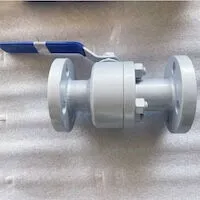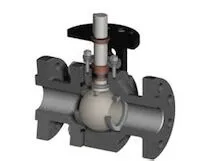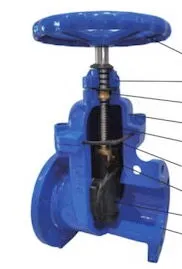Forms, End Distance and Flow Path of Regulating Valves
Feb 28, 2022
Control valves are also called regulating valves. The national standard GB/T 17213.1-2015 defines the terms and general rules of the control valve. The control valve is the terminal control element of automatic control, which is used to adjust the flow, pressure and liquid level of the medium. It is important in the whole control loop to determine whether the process control is timely, effective and safe. This paper discusses and analyzes the technology of straight stroke regulating valves produced by most manufacturers.
Valve Body
It is the main part of the valve body, which is used to connect pipelines and realize fluid passage, and can be used to place valve internals, contact various media and bear fluid pressure. It should meet the requirements of service pressure, temperature, erosion and corrosion conditions, and determine the structure, connection and materials of the valve body according to engineering practice and installation requirements. Generally, the valve body is made of casting (including die-casting), forging (including die forging) or rod-shaped materials. From hot working to cold working, the casting blanks, forging materials and rod-shaped profiles are machined to a certain size.
Valve Body Type
There are various types of straight stroke control valves, including single-seat valves, double-seat valves, sleeve (cage) valves, angle valves, three-way valves, diaphragm valves, pipe clamp valves, angle seat valves (also known as inclined seat valves and Y-type valves), slide valves and so on. In addition, there are some specially designed valve bodies that meet special working conditions or special user requirements, such as valve bodies with hot jackets, detachable valve bodies fastened by clamps, forged valve bodies of high-pressure angle valves, etc.
End Distance of the Valve Body
The standard of industrial control valves clearly stipulates the end face spacing of straight stroke valve body at a given nominal diameter and nominal pressure, and most control valves with flange connection or butt welding connection conform to the standardized end face spacing. For the flat flange and convex flange that pass through the valve body, the size is from the flange end face to the flange end face (FTF);
For the plane flange and convex flange of the angle valve body, the dimension is from the flange centerline to the flange end face (CTF), which is the same as the general standard representation of flange. For convex flange, the dimension of FTF and CTF includes the convex surface.
The end distance of straight-through and annular flange of the single-seat valve can be checked in IEC 60534-3-1(GB/T 17213.3), the end distance of butt welding type of single-seat valve can be checked in IEC 60534-3-3(GB/T 17213.12) and the end distance of angular stroke valve can be checked in IEC 60534-3-2 (GB/T17213). American standard can be found in ANSI/ISA 75.8.01 to 75.8.09. Nine standards have made detailed provisions on the end distance of different valve types and different pounds.
Valve Flow Path
The flow path design in the valve body involves the influence on the fluid flow, and the internal structure shape (geometric shape coefficient) of the valve body affects the pressure recovery coefficient FL. Different valve bodies have different pressure recovery capacities and pressure recovery coefficients due to different structures, so the flow resistance and pressure loss are concerned. The valve body has a good flow path, small flow resistance and better pressure recovery ability; The flow path is complex, the flow resistance is large, the friction loss is large, and the pressure recovery ability is also poor. The pressure recovery coefficient FL directly affects the calculation of whether incompressible liquid blocks turbulent flow or not and the calculation of fluid Reynolds number. Whether turbulence is blocked or not is related to the maximum discharge coefficient, cavitation and noise. The pressure recovery coefficient FL is determined by the manufacturer's type test, and there are specific values for different valve types and different openings. Generally, these self-owned data only exist in each manufacturer's special control valve calculation software. If the general control valve calculation software is used and the typical pressure recovery coefficient FL value of valve type recommended in the IEC 60534 standard is selected for calculation, the result may be far from the manufacturer's calculation data and actual product specifications. Because the products of different manufacturers of the same valve type have their valve body flow path design differences, the pressure recovery coefficient FL of the specific valve type is different from the typical value recommended by the standard. Coupled with the different design of valve internals, there is a phenomenon that the same valve type has the same nominal diameter and similar flow coefficient, but the stroke is quite different. For example, the flow coefficient Cv of DN50(NPS 2) control valve is basically around 45, the stroke of a brand control valve is 15mm, and that of other manufacturers is mostly 20-25mm; The flow coefficient Cv of DN80(NPS 3) control valve is basically around 100, the stroke of one brand control valve is still 15mm, and that of other manufacturers is mostly 30-40mm. The flow coefficient per unit stroke varies greatly, and the sensitivity of the valve varies greatly, including the design of the valve body flow path.
Single-seat valve is a low-pressure recovery valve with an S-shaped flow path in the valve body, and the pressure recovery coefficient FL is large, ranging from 0.8 to 0.9, with low-pressure recovery capability, among which the pressure recovery coefficient FL of the flow-off control valve is slightly smaller than that of the similar valve of the flow-on type. How to reduce the pressure recovery coefficient FL, make the pressure recover better-better, improve the blocking flow condition and increase the flow capacity is the research and development focus of many manufacturers, and there are also improvements and innovations in the design of valve body flow path. The control valve plays an important role in process control, and the valve body is directly connected with the process flow path, ensuring the circulation of various media, bearing the fluid pressure and meeting the requirements of working conditions, and at the same time, the shape, structure and connection should meet the needs of users. Choosing the right valve body type, designing the valve body flow path reasonably and using the valve body material economically are the basic requirements for producing and customizing control valves.
Valve Body
It is the main part of the valve body, which is used to connect pipelines and realize fluid passage, and can be used to place valve internals, contact various media and bear fluid pressure. It should meet the requirements of service pressure, temperature, erosion and corrosion conditions, and determine the structure, connection and materials of the valve body according to engineering practice and installation requirements. Generally, the valve body is made of casting (including die-casting), forging (including die forging) or rod-shaped materials. From hot working to cold working, the casting blanks, forging materials and rod-shaped profiles are machined to a certain size.
Valve Body Type
There are various types of straight stroke control valves, including single-seat valves, double-seat valves, sleeve (cage) valves, angle valves, three-way valves, diaphragm valves, pipe clamp valves, angle seat valves (also known as inclined seat valves and Y-type valves), slide valves and so on. In addition, there are some specially designed valve bodies that meet special working conditions or special user requirements, such as valve bodies with hot jackets, detachable valve bodies fastened by clamps, forged valve bodies of high-pressure angle valves, etc.
End Distance of the Valve Body
The standard of industrial control valves clearly stipulates the end face spacing of straight stroke valve body at a given nominal diameter and nominal pressure, and most control valves with flange connection or butt welding connection conform to the standardized end face spacing. For the flat flange and convex flange that pass through the valve body, the size is from the flange end face to the flange end face (FTF);
For the plane flange and convex flange of the angle valve body, the dimension is from the flange centerline to the flange end face (CTF), which is the same as the general standard representation of flange. For convex flange, the dimension of FTF and CTF includes the convex surface.
The end distance of straight-through and annular flange of the single-seat valve can be checked in IEC 60534-3-1(GB/T 17213.3), the end distance of butt welding type of single-seat valve can be checked in IEC 60534-3-3(GB/T 17213.12) and the end distance of angular stroke valve can be checked in IEC 60534-3-2 (GB/T17213). American standard can be found in ANSI/ISA 75.8.01 to 75.8.09. Nine standards have made detailed provisions on the end distance of different valve types and different pounds.
Valve Flow Path
The flow path design in the valve body involves the influence on the fluid flow, and the internal structure shape (geometric shape coefficient) of the valve body affects the pressure recovery coefficient FL. Different valve bodies have different pressure recovery capacities and pressure recovery coefficients due to different structures, so the flow resistance and pressure loss are concerned. The valve body has a good flow path, small flow resistance and better pressure recovery ability; The flow path is complex, the flow resistance is large, the friction loss is large, and the pressure recovery ability is also poor. The pressure recovery coefficient FL directly affects the calculation of whether incompressible liquid blocks turbulent flow or not and the calculation of fluid Reynolds number. Whether turbulence is blocked or not is related to the maximum discharge coefficient, cavitation and noise. The pressure recovery coefficient FL is determined by the manufacturer's type test, and there are specific values for different valve types and different openings. Generally, these self-owned data only exist in each manufacturer's special control valve calculation software. If the general control valve calculation software is used and the typical pressure recovery coefficient FL value of valve type recommended in the IEC 60534 standard is selected for calculation, the result may be far from the manufacturer's calculation data and actual product specifications. Because the products of different manufacturers of the same valve type have their valve body flow path design differences, the pressure recovery coefficient FL of the specific valve type is different from the typical value recommended by the standard. Coupled with the different design of valve internals, there is a phenomenon that the same valve type has the same nominal diameter and similar flow coefficient, but the stroke is quite different. For example, the flow coefficient Cv of DN50(NPS 2) control valve is basically around 45, the stroke of a brand control valve is 15mm, and that of other manufacturers is mostly 20-25mm; The flow coefficient Cv of DN80(NPS 3) control valve is basically around 100, the stroke of one brand control valve is still 15mm, and that of other manufacturers is mostly 30-40mm. The flow coefficient per unit stroke varies greatly, and the sensitivity of the valve varies greatly, including the design of the valve body flow path.
Single-seat valve is a low-pressure recovery valve with an S-shaped flow path in the valve body, and the pressure recovery coefficient FL is large, ranging from 0.8 to 0.9, with low-pressure recovery capability, among which the pressure recovery coefficient FL of the flow-off control valve is slightly smaller than that of the similar valve of the flow-on type. How to reduce the pressure recovery coefficient FL, make the pressure recover better-better, improve the blocking flow condition and increase the flow capacity is the research and development focus of many manufacturers, and there are also improvements and innovations in the design of valve body flow path. The control valve plays an important role in process control, and the valve body is directly connected with the process flow path, ensuring the circulation of various media, bearing the fluid pressure and meeting the requirements of working conditions, and at the same time, the shape, structure and connection should meet the needs of users. Choosing the right valve body type, designing the valve body flow path reasonably and using the valve body material economically are the basic requirements for producing and customizing control valves.
Previous: Problem Research of Special Valves
Next: 20 Items Marked for 5S Management in Valve Workshop



